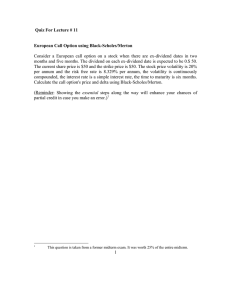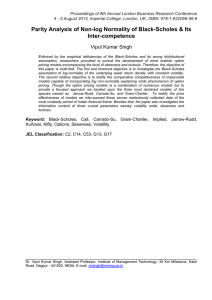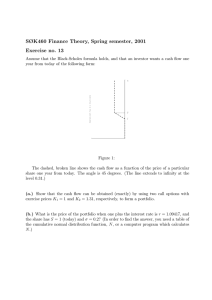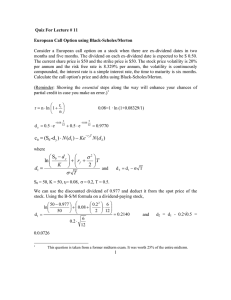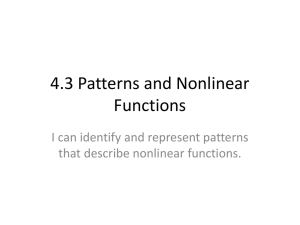Nonlinear Black-Scholes Equation Through Radial Basis Functions
advertisement
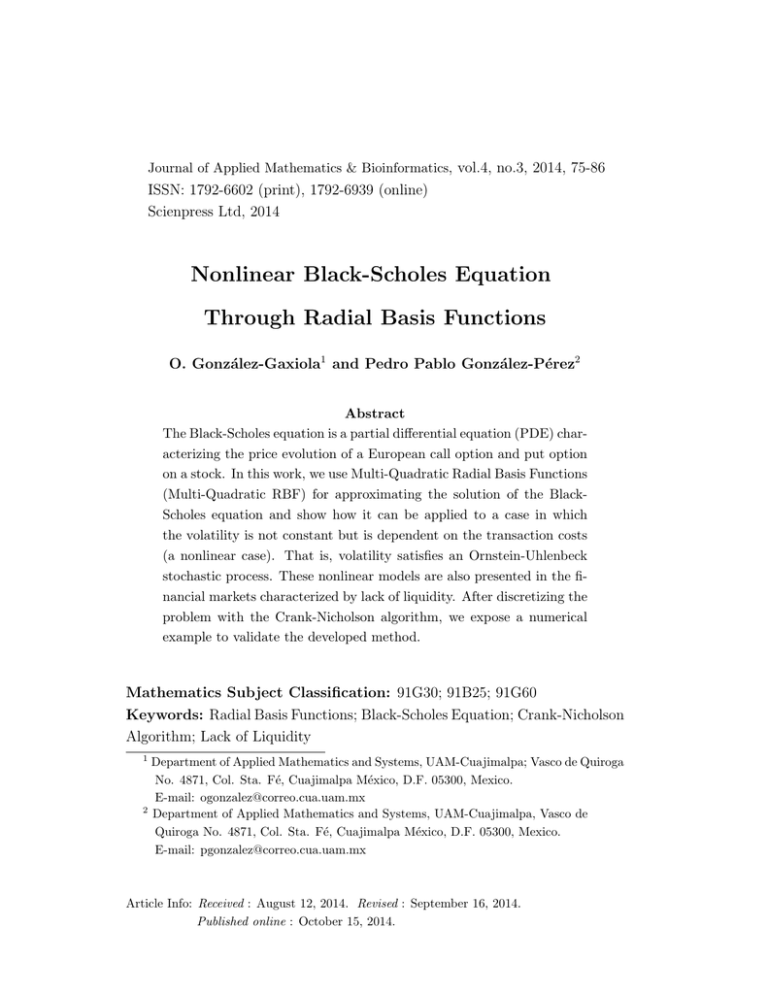
Journal of Applied Mathematics & Bioinformatics, vol.4, no.3, 2014, 75-86
ISSN: 1792-6602 (print), 1792-6939 (online)
Scienpress Ltd, 2014
Nonlinear Black-Scholes Equation
Through Radial Basis Functions
O. González-Gaxiola1 and Pedro Pablo González-Pérez2
Abstract
The Black-Scholes equation is a partial differential equation (PDE) characterizing the price evolution of a European call option and put option
on a stock. In this work, we use Multi-Quadratic Radial Basis Functions
(Multi-Quadratic RBF) for approximating the solution of the BlackScholes equation and show how it can be applied to a case in which
the volatility is not constant but is dependent on the transaction costs
(a nonlinear case). That is, volatility satisfies an Ornstein-Uhlenbeck
stochastic process. These nonlinear models are also presented in the financial markets characterized by lack of liquidity. After discretizing the
problem with the Crank-Nicholson algorithm, we expose a numerical
example to validate the developed method.
Mathematics Subject Classification: 91G30; 91B25; 91G60
Keywords: Radial Basis Functions; Black-Scholes Equation; Crank-Nicholson
Algorithm; Lack of Liquidity
1
Department of Applied Mathematics and Systems, UAM-Cuajimalpa; Vasco de Quiroga
No. 4871, Col. Sta. Fé, Cuajimalpa México, D.F. 05300, Mexico.
E-mail: ogonzalez@correo.cua.uam.mx
2
Department of Applied Mathematics and Systems, UAM-Cuajimalpa, Vasco de
Quiroga No. 4871, Col. Sta. Fé, Cuajimalpa México, D.F. 05300, Mexico.
E-mail: pgonzalez@correo.cua.uam.mx
Article Info: Received : August 12, 2014. Revised : September 16, 2014.
Published online : October 15, 2014.
76
1
Nonlinear Black-Scholes Equation Through Radial Basis Functions
Introduction
In finance, a financial derivative (or derivative) is a financial product whose
value varies depending on the price of another asset; the asset of which depends
takes the name of the underlying asset (e.g., stock, commodity, futures and
index). In practice, the options are a type of derivative, i.e., a contract which
we have the option to buy or sell a certain underlying asset at a certain date
and at a price established. Therefore, an option can be a purchase option or a
selling option, called call option and put option, respectively. Commonly, an
option is valued using the Black-Scholes model, which is a partial differential
equation which, when solved, produces a function that allows us to know the
price of a derivative, depending on the underlying asset price and time. As the
name suggests, this model was proposed by Fischer Black and Myron Scholes
[1]. Subsequently, Robert Merton published a paper with a deeper and more
consistent development of the mathematical model. As a historical note, it is
worth noting that Merton and Scholes received the Nobel Prize in Economics
in 1997, by the Royal Swedish Academy of Sciences; F. Black had died in 1995.
The Black-Scholes equation (in standard linear version [1], [5]) has been
studied in many articles from various points of view; for example, in [3] this
equation was studied using the theory of semigroups of operators; in [4] the
same equation is solved using the theory of special functions; and in [2] a
study for the valuation of financial derivatives with time-dependent parameters
approach was carried out.
In this paper we study the Black-Scholes equation for a nonlinear case, first
by an interpolation by Multi-Quadratic RBF and then followed by a CrankNicholson type algorithm [12] to find a solution to the nonlinear variant, which
has been proposed mainly in the work [7] and [8], in financial markets characterized by lack of liquidity.
Accordingly, we first derive the Black-Scholes model for both the standard
case and the nonlinear case (Section 2). Then (Section 3) we present a brief introduction to the scheme of Radial Basis Functions (RBF). After, an approach
to nonlinear Black-Scholes model using the radial basis functions as interpolator is developed, then the efficiency of the method is illustrated following a
Crank-Nicholson type scheme (Section 4). We conclude with some remarks on
Black-Scholes model and the method used for approximating a solution of this
O. González-Gaxiola and Pedro Pablo González-Pérez
77
equation (Section 5).
2
The Black-Scholes: The Nonlinear Case
This model is a partial differential equation whose solution describes the
value of an European Option, see [1], [5]. Nowadays, it is widely used to estimate the pricing of options other than the European ones. Let (Ω, F, P, Ft≥0 )
be a filtered probability space and let Bt be a brownian motion in R. We will
consider the stochastic differential equation (SDE)
dX(t) = a(t, X(t))dt + σ(t, X(t))dB(t),
with a and σ continuous in (t, x) and Lipschitz continuous in x; i.e., there is
a constant M such that
|a(t, x) − a(t, y)| ≤ M |x − y|, |σ(t, x) − σ(t, y)| ≤ M |x − y| ∀ t, x, y.
The price processes is given by the geometric brownian motion S(t), S(0) = x0 ,
solution of the SDE
dS(t) = µS(t)dt + σS(t)dB(t),
with µ and σ constants. It is well know that the solution of this SDE is given
by:
1
dS(t) = x0 exp{σ(B(t) − B(t0 )) + (r − σ 2 )(t − t0 )}
2
Let 0 ≤ t < T and h be a Borel measurable function, h(X(T )) denotes the
contingent claim, let E x,t h(X(T )) be the expectation of h(X(T )), with the
initial condition X(t) = x.
Now we recall the Feynman–Kac theorem [6]. Let v(t, x) = E x,t h(X(T ))
be, 0 ≤ t < T , where dX(t) = a(X(t))dt + σ(X(t))dW (t). Then
1
vt (t, x) + a(x)vx (t, x) + σ 2 (x)vxx (t, x) = 0, and v(T, x) = h(x).
2
(1)
Now, if we consider the discounted value
u(t, x) = e−r(T −t) E x,t h(X(T )) = e−r(T −t) v(t, x).
(2)
78
Nonlinear Black-Scholes Equation Through Radial Basis Functions
Then if at time t, S(t) = x, we proceed in a standard way,
v(t, x) = er(T −t) u(t, x),
vt (t, x) = −rer(T −t) u(t, x) + er(T −t) ut (t, x),
vx (t, x) = er(T −t) ux (t, x),
vxx (t, x) = er(T −t) uxx (t, x).
The Black-Scholes equation is obtained substituting the above equalities in the
equation (1) and multiplying by the factor e−r(T −t) :
1
−ru(t, x) + ut (t, x) + rxux (t, x) + σ 2 x2 uxx (t, x) = 0,
2
(3)
where 0 ≤ t < T, and x ≥ 0; here the risk-free interest rate r and the volatility σ are taken constants.
In financial models, we usually assumed that the markets are competitive
and there is no friction of any kind, i.e. there are no transaction costs and
there is ample liquidity such that a trader can buy or sell any number of
assets without changing its price. In some financial models [7],[8], for very
short periods of time, the volatility σ can be a function that depends on the
transaction cost or the second derivative of the asset value while the interest
rate r, is a constant. The idea is that not only the asset price but also the
volatility, is a stochastic process [9]. If the volatility satisfies the OrnsteinUhlenbeck process we have the two equations
dS(t) = µS(t)dt + σ(t)S(t)dW1 (t)
dσ(t) = −βσ(t)dt + δdW2 (t),
the processes W1 (t) and W2 (t) are not independent and must be Corr(W1 (t), W2 (t)) =
ρ, where |ρ| << 1. Using the Itô’s lema, we can obtain an expression for the
stochastic differential of dσ 2 (t), which happens to be
dσ 2 (t) = [2δ 2 − βσ 2 (t)]dt + 2δσ(t)dW2 (t)
such that eq.(3) with β = 1 becomes the non-linear equation:
1
uxx (t, x)
ut (t, x) + σ 2 x2 ·
= 0.
2
(1 − ρxλ(x)uxx (t, x))2
(4)
O. González-Gaxiola and Pedro Pablo González-Pérez
79
If we consider the special case where the price of risk is unit, λ(x) = 1 and if we
further assume that ||ρxuxx || < ² for some ² > 0 small enough (low impact of
1
hedging) and considering the functional approximation (1−F
≈ 1+2F +O(F )3
)2
we have that eq.(4) becomes
1
ut (t, x) + σ 2 x2 · uxx (t, x)(1 + 2ρxuxx (t, x)) = 0.
2
3
(5)
Radial Basis Functions
Definition 3.1. A radial basis function φ : R+ → R+ is a continuous
function of the form φ(r) which depends upon the separation distances r =
~ of a set of nodes Π ⊂ Rd also called centres, ζ~ = (ζj ) ∈ Π for all
||~x − ζ||
j = 1, 2, . . . , N .
Due to their spherical symmetry about the points ζj these functions are termed
~ are usually measured using the euclidean
radial. The distances r = ||~x − ζ||
norm. A typical radial basis function (RBF) usually has the form
~
φ(r) = (²||~x − ζ||)
(6)
where ² means the shape parameter of the radial basis function. Some of the
most popular used RBFs are showed in Table 1.
The Multiquadratic RBF is also sometimes called Hardy’s multiquadratic,
is so called due to the seminal work of Hardy written in 1971 [10].
Another key feature of the RBF method is that it is mesh-free, which means
that it does not require a grid. It only depends on distances to center points ζj
in the approximation. As pairwise distances are very easy to compute in any
number of space dimensions, it also works well for high-dimensional problem.
A standard RBF interpolant is a linear combination of RBFs φ centered at
the scattered points ζj , j = 1, 2, . . . , N which has the following form
S(~x, ²) =
N
X
j=1
λj φ(²||~x − ζ~j ||) =
N
X
j=1
λj φj (~x),
(7)
80
Nonlinear Black-Scholes Equation Through Radial Basis Functions
the coefficients (unknown) λj are determined through the interpolation condition S(ζj , ²) = f (ζj ) and can be computed as the solution of the following
linear system
Aφ~λ = f~,
(8)
where the symmetric matrix Aφ is given by [aij ] = φj (ζi ) = φ(²||~x − ζ~j ||), and
~λ , f~ are column vectors.
Function
Gaussian (GA)
Multiquadric (MQ)
Inverse Multiquadric (IMQ)
Expression
2
φ(r) = e−(²r)
p
φ(r) = (²r)2 + c2
φ(r) = √ 1 2
Inverse Quadric (IQ)
φ(r) =
Sigmoid (S)
φ(r) =
1+(²r)
1
1+(²r)2
1
1+e−(²r)
Table 1: Examples of Radial Basis Functions (RBF).
Furthermore, the implementation of a RBF method is also straightforward.
However, there are still some issues left such as stability for the time-dependent
problems and computational efficiency [11]. With the advantages mentioned
above of achieving spectral accuracy using infinitely smooth basis functions,
the geometrical flexibility with arbitrary choice of node locations and the ease
of implementation, radial basis function (RBF) approximation is rising as an
important method for interpolation, approximation, and solution of partial
differential equations (PDE).
4
Black-Scholes and Radial Basis Functions
Now we will consider Black-Scholes equation (nonlinear) (5), using more
conventional symbology
∂U
1
∂ 2U ³
∂ 2U ´
+ σ 2 x2 ·
1
+
2ρx
= 0.
∂t
2
∂x2
∂x2
(9)
O. González-Gaxiola and Pedro Pablo González-Pérez
81
The initial condition is given by the terminal payoff valuation
(
max{K − x, 0}
for put
U (x, T ) =
max{x − K, 0}
for call
where T is the time of maturity and K is the strike price of the european-type
option.
As mentioned in last section, there are many types of RBF such as Gaussians, Sigmoid, Multiquadratics and Inverse Multiquadratics (among many
other). In our example we select Hardys Multi-quadratic (MQ), which can
be written in terms of the log stock price x (the independent variable in one
dimension) as (with ² = 1)
q
~
(10)
φ(||~x − ζj ||) = (x − ζj )2 + c2
The derivatives of φ can be easily calculated as
x − ζj
∂φ
=p
∂x
(x − ζj )2 + c2
(11)
∂ 2φ
(x − ζj )2
1
p
p
−
=
∂x2
(x − ζj )2 + c2 ( (x − ζj )2 + c2 )3
(12)
Using these definitions, we can now propose an approximation for the option
price U, solution of the equation (9)
U (x, t) =
N
X
λj (t)φ(||~x − ζ~j ||)
(13)
j=1
The derivatives of this approximation are
N
X
∂U
∂φ(||~x − ζ~j ||)
=
λj (t)
∂x
∂x
j=1
(14)
N
X
∂ 2 φ(||~x − ζ~j ||)
∂ 2U
=
λ
(t)
j
∂x2
∂x2
j=1
(15)
N
X ∂λj (t)
∂U
=
φ(||~x − ζ~j ||)
∂t
∂t
j=1
(16)
82
Nonlinear Black-Scholes Equation Through Radial Basis Functions
Now that we have discretized all parts of the equation (9), we will use an iterative method, Crank-Nicholson-type, see reference [12] for more information, we
obtain
F U (t+∆t) = GU (t)
(17)
where
U (t) = U (x, t), U (t+∆t) = U (x, t + ∆t),
³1
∂2 h
∂ 2 i´
G = 1 − θ∆t σ 2 x2 · 2 1 + 2ρx 2 ,
2
∂x
∂x
³1
2 h
∂
∂ 2 i´
2 2
F = 1 + (1 − θ)∆t σ x · 2 1 + 2ρx 2
2
∂x
∂x
here, ∆t is the time step size and the parameter θ running in the range
0 ≤ θ ≤ 1, θ is the Crank-Nicholson parameter and fixed once chosen. The
price U = U (x, t) governed by (9) will be estimated with the RBF as in the
equation (13), i.e.
U
(t)
=
N
X
λj (t)φ(||~x − ζ~j ||)
(18)
j=1
where N denote the total number of data points. Substituting (18) into (17),
we obtain
N
X
j=1
(t+∆t)
F λj
(t)φ(||~x
− ζ~j ||) =
N
X
(t)
Gλj (t)φ(||~x − ζ~j ||)
(19)
j=1
The Crank-Nicholson scheme suggests the algorithm of seven steps, illustrated
in Table 2.
4.1
An Illustrative Example
Our illustrative example considers the data of Black-Scholes model for the
case of a European option as illustrated in Table 3. The algorithm was implemented in MATLAB 5.2 by Scientific Word 3.0, considering N = 125.
The parameter c in equation (10) allows us to adjust the error committed
when RBF approach is used to approximate the solution of a partial differential
equation i.e., Black Scholes equation (9) with an algorithm as shown in Table
O. González-Gaxiola and Pedro Pablo González-Pérez
Step
step 1
step 2
step
step
step
step
step
3
4
5
6
7
83
Steps of the algorithm
Discretize from t = 0 to t = T with time-step ∆t = T /N
Specify U (T ) at the expire time T from the boundary condition and
(T )
calculate λj at time T
Make t = T − ∆t
(k)
Calculate λj with (19) for every k
Make t = T − ∆t
Repeat step 4 and step 5 if 1 ≤ j ≤ N
P
Evaluate U (0) = N
x − ζ~j ||)
j=1 λj (0)φ(||~
Table 2: Data of Black-Scholes model for the case of a european option.
Parameter
Value
Maturity time
T = 6 months
Strike price
K = $15
Interest rate
r = 0.01
Volatility
σ = 0.1
Crank-Nicholson parameter θ = 0.6
2. As can be seen in [13], the value taken by the parameter c is inversely
proportional to coefficient λ appearing in (8) (remember that this case is 1dimensional, so λ ∈ R).
The results of such approach can be seen in Table 4. Note that for this example
we consider c = 0.999 and therefore λ ≈ 4.004, which produces an error less
than 2.8 × 10−4 .
5
Summary
In this paper, we used Multi-Quadratic Radial Basis Functions for approximating the solution of the Black-Scholes equation, for a situation characterized
by a non-constant volatility, but that depends on transaction costs (i.e., a
nonlinear case). Such nonlinear models frequently occur in financial markets
characterized by a lack of liquidity. First, an approximate solution was ob-
84
Nonlinear Black-Scholes Equation Through Radial Basis Functions
Table 3: Results of the numerical example in the validation of the developed method.
Stock x
25
30
35
40
45
50
75
100
150
200
Uusing RBF
1.8682741
5.0188546
8.3181237
11.7350982
15.2483041
18.8420513
37.6833322
57.4912555
98.7814899
141.4388217
Uanalytical
1.8682866
5.0188442
8.3181066
11.735099
15.248305
18.842061
37.683321
57.491263
98.78149
141.43881
tained by means of Multi-Quadratic RBF, then the problem was discretized
and the Crank-Nicholson algorithm was used. As a final point, a numerical
example to validate the developed method has been given, achieving an approximation with an error less than 2.8×10−4 . As part of our future directions, we
intend to discretize the Black-Scholes equation for some particular investment
and get solutions through evolutionary algorithms or attempt to address the
problem using artificial neural networks based on Radial Basis Functions [14].
ACKNOWLEDGEMENTS. The authors are grateful to the referees for
their suggestions which helped to improve the paper.
References
[1] F. Black and M. Scholes, The Pricing Options and Corporate Liabilities,
Journal of Political Economy, 81, (1973), 637-659.
O. González-Gaxiola and Pedro Pablo González-Pérez
85
[2] C. F. Lo, C.H. Hui, Valuation of financial derivatives with time-dependent
parameters: Lie-algebraic approach, Quantitative Finance, 1, (2001),
7378.
[3] O. González-Gaxiola, José A. Santiago, The Black-Scholes Operator as
the Generator of a C0 -Semigroup and Applications, Int. Journal of Pure
and Applied Math., 76(2), (2012),191-200.
[4] O. Gonzalez-Gaxiola, J. A. Santiago, An α-Mellin transform and some
of its applications, Int. Journal of Contemp. Math. Sciences, 7 (45-48),
(2012), 2353-2361.
[5] R.C. Merton, heory of Rational Options Pricing, Bell Journal of Economic
and Management Science, 4, (1973), 141-183.
[6] S. Shreve, Stochastic Calculus for Finance II: Continuous-Time Models,
Springer Finance, 2004.
[7] R. Frey, Market illiquidity as a source of model risk in dynamic hedging, ed. by R. Gibson, Risk Publications, pp. 125-136, Risk Publications,
London, 2000.
[8] U. Cetin, R. Jarrow, P. Protter, Liquidity risk and arbitrage pricing theory, Finance Stoch., 8, (2004), 311-341.
[9] L. Steven, A. Heston, Closed-form Solution for Options with Stochastic
Volatility with Applications to Bond and Currency Options, The Review
of Financial Studies, 6(2), (1993).
[10] R.L. Hardy, Multiquadric equations of topography and other irregular
surfaces, J. Geophys. Res., 76, (1971), 1905-1915.
[11] J. Park, I. W. Sandberg, Universal Approximation Using Radial-BasisFunction Networks, Neural Computation, 3(2), (1991), 246-257.
[12] J. Crank, P. Nicholson, A practical method for numerical evaluation of solutions of partial differential equations of the heat-conduction type; Proc.
Cambridge Philos. Soc., 43, (1947), 5067.
86
Nonlinear Black-Scholes Equation Through Radial Basis Functions
[13] E.J. Kansa, Multiquadratics: A scattered data approximation scheme
with applications to computational fluid dynamics. I. Surface approximations and partial derivative estimates, Comput. Math. Applic., 19 (8/9),
(1990), 127-145.
[14] O. González-Gaxiola, Pedro Pablo González-Pérez, Applying the Fock
spaces-based tools to the modeling of RBF neural networks: a quantum
RBF neural network approach, Journal of Applied Mathematics & Bioinformatics, 13(3), (2013), 89-102.

